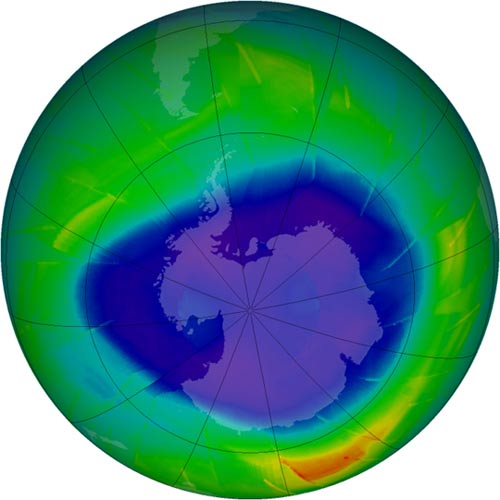Ozone hole ... is shrinking
World Meteorological Organization (WWO) predicts ozone depletion in Antarctica, this year, is likely to be smaller than the loss in 2008.
" Climatic conditions, so far to date, show that the ozone layer hole in 2009 will be smaller than the gap in 2006 and 2008 ," the United Nations Agency said.
Antarctic ozone hole was discovered in the 1980s. This hole usually begins to form in August every year and reaches the maximum width at the end of September or early October, before it dies in the month. 12. The ozone hole area depends very much on the weather conditions each year.
Geir Braathen, WMO's ozone layer expert, said that this year the ozone layer hole appeared earlier than usual. The area of the hole measured on September 16, is 14 million km 2 . Meanwhile, the maximum width of the hole measured in 2008 was 27 million km 2 and in 2007 it was 25 million km 2 .

(Photo: NASA)
Experts also warned that the ozone layer hole in Antarctica was only fully healed, as early as 2075.
The ozone layer is very important for life on Earth, it helps us avoid the harmful effects of ultraviolet rays from the Sun. Direct exposure to ultraviolet rays can cause skin burns and skin cancer. In addition, ultraviolet rays also damage plants .
Gases such as carbon (CFC) are used in modern equipment such as air conditioners, refrigerators, fire extinguishers, etc., which cause ozone layer holes. In 1987, the Protocol of Montreal Protocol decided the type of gas harmful to the ozone layer, away from industrial production. However, its harmful effects on the environment will last for many years.
- The hole in the Antarctic ozone layer is shrinking
- The ozone hole can be healed in 2070
- Antarctic ozone holes are shrinking
- Ozone holes in Antarctica show signs of shrinking
- The ozone gap in Antarctica is the smallest in nearly 3 decades
- Ozone layer: 60 years to recover!
- New discovery of the ozone layer gap in Antarctica
- September 9: First discovered ozone hole in a populous city
- Ozone floor gaps are narrowing but will need another 60 years to fully recover
- Still need to be alert for ozone layer hole
- The person who discovered the ozone layer hole died
- Can not quickly overcome the hole of Ozone layer
 Is the magnetic North Pole shift dangerous to humanity?
Is the magnetic North Pole shift dangerous to humanity? Washington legalizes the recycling of human bodies into fertilizer
Washington legalizes the recycling of human bodies into fertilizer Lightning stone - the mysterious guest
Lightning stone - the mysterious guest Stunned by the mysterious sunset, strange appearance
Stunned by the mysterious sunset, strange appearance Unusual polar vortex appears in Antarctica
Unusual polar vortex appears in Antarctica  Hot weather in Europe causes ozone pollution to harmful levels
Hot weather in Europe causes ozone pollution to harmful levels  Earth has a new hole, 7 times larger than the hole in the Antarctic ozone layer
Earth has a new hole, 7 times larger than the hole in the Antarctic ozone layer  Insects lose their sense of smell because of air pollution, humans go to pollinate plants themselves
Insects lose their sense of smell because of air pollution, humans go to pollinate plants themselves  Why did the Arctic ozone hole just suddenly close?
Why did the Arctic ozone hole just suddenly close?  The recovering ozone layer diverts global winds
The recovering ozone layer diverts global winds 